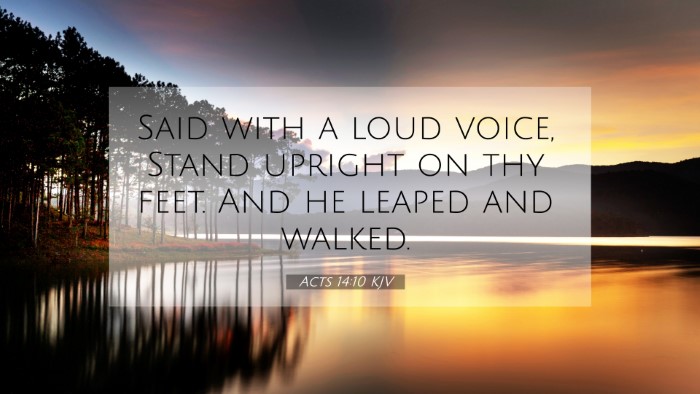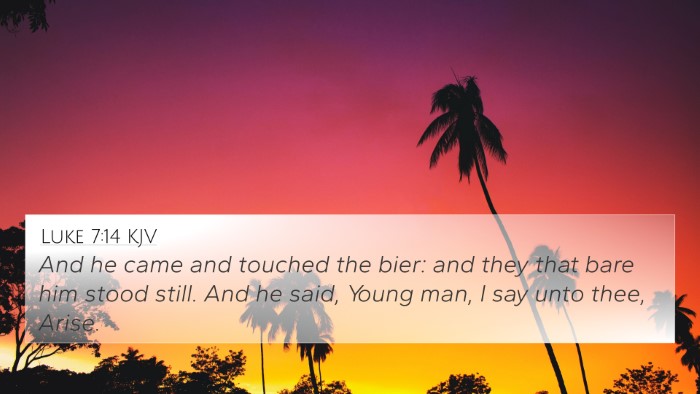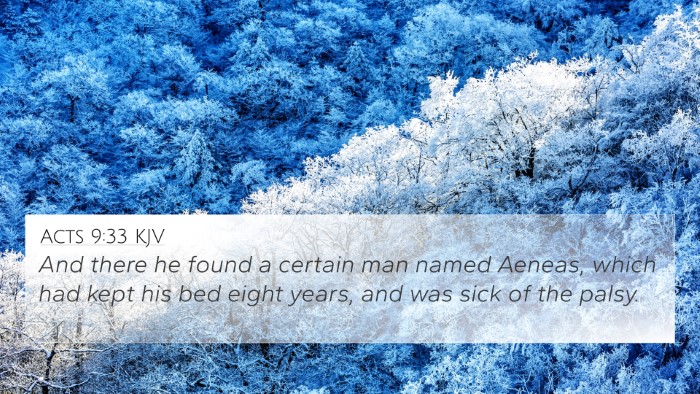Understanding Acts 14:10: A Comprehensive Analysis
Acts 14:10 states: "Said with a loud voice, 'Stand upright on your feet.' And he sprang up and began to walk." This verse highlights the miraculous healing of a lame man in Lystra by the Apostle Paul, showcasing the power of faith and the authority of God's servants. Below, we provide insights from renowned public domain commentaries, including those by Matthew Henry, Albert Barnes, and Adam Clarke.
Commentary Insights
Matthew Henry
Matthew Henry emphasizes the miraculous nature of this instance as a demonstration of God's power to heal and restore. He notes that this event occurred in a place where the people were unaware of the true nature of divine authority, yet they responded with faith. Henry argues that the healing illustrates the influence of divine command and faith, not just in physical health but also in spiritual salvation.
Albert Barnes
Albert Barnes focuses on the faith of the healed man. He points out that Paul noticed the man's faith to be healed, indicating a connection between belief and divine intervention. Barnes also highlights the reaction of the crowd, who attempted to worship Paul and Barnabas as gods, illustrating the common response to the miraculous in a polytheistic context. This points to the necessity for clarification of who truly deserves worship—God alone.
Adam Clarke
Adam Clarke elaborates on the reaction of both the audience and the apostles. Clarke notes that the man's immediate ability to walk indicates a complete and instantaneous healing. He discusses the importance of this event in establishing the credibility of the Gospel message in a region that was largely pagan. Clarke also emphasizes the role of the apostles as instruments of God's power, underscoring that miracles serve the purpose of confirming the message of Christ.
Bible Cross-References
Acts 14:10 connects with several other Bible passages that enhance its meaning and provide further context:
- John 5:8-9: Jesus heals a paralytic, emphasizing authority over sickness.
- Luke 7:14-15: Jesus raises the widow's son, demonstrating His power over death.
- James 5:14-15: The prayer of faith can heal the sick, connecting to the faith displayed in Acts 14:10.
- Matthew 9:5-6: Jesus asks, "Is it easier to say your sins are forgiven, or arise and walk?" linking healing and forgiveness.
- Acts 3:6-8: Peter heals a lame man at the temple, paralleling the miraculous work of the apostles.
- Mark 16:17-18: Jesus promises that believers will perform miracles, correlating with Paul’s actions.
- Romans 10:17: "Faith comes by hearing," addressing the man's faith in response to Paul’s preaching.
Thematic Connections
In examining Acts 14:10, we witness various themes that emerge across the scripture:
- Faith: The act of the lame man responding to Paul's call depicts the profound role of faith in miracles.
- The Power of God: Each healing miracle signifies God’s sovereignty and power to transform lives.
- Discipleship: The apostles' role denotes the importance of spreading the Gospel and affirming its truth through signs and wonders.
- Public Response: The crowd's reaction sheds light on the challenges believers face in preventing misunderstandings about divine authority.
- Human Condition: The healing illustrates God’s concern for human suffering and His desire for holistic restoration.
- Cultural Context: Understanding the audience's polytheistic beliefs is essential for grasping the narrative’s significance.
Conclusion: The Impact of Acts 14:10
Acts 14:10 serves as a crucial text that underlines the significance of faith, the demonstration of divine authority through miracles, and the role of God's messengers in communicating His truth. The connections drawn from other biblical passages enrich our understanding, illustrating the theme of God working through believers to bring healing and restoration. This verse not only stands alone but resonates throughout the entire narrative of scripture, encouraging ongoing cross-referencing and thematic exploration.









